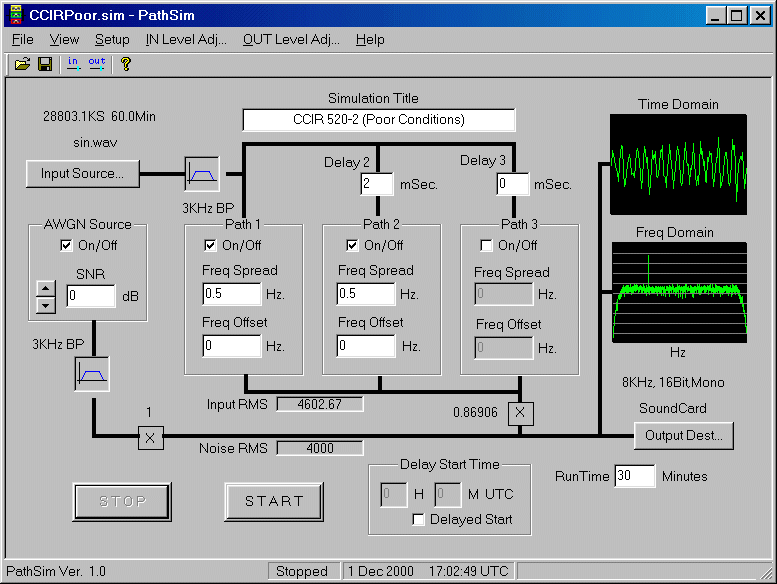
Introduction
PathSim is a Windows program that can be used to simulate radio propagation paths using a soundcard and/or wave files as the source and destination.
The main screen is fairly descriptive of the signal processing paths. Three HF paths are available though usually only two are used.
Each simulation "session" can be titled and saved to a file for future retrieval. A set of canned simulations are included in this zip file and are somewhat standard test conditions.
The real input signal can come from either the soundcard or a wave file. It is first bandpass filtered and converted to an I/Q complex signal using a Hilbert transform(incorporated in the bandpass filter). Three paths are then created with two of them having a variable time delay.
Each Path has a Spreading frequency selection and a frequency offset parameter. The spreading is performed by low pass filtering a complex AWGN signal to the desired bandwidth and then multiplying by the incoming complex signal.
Each path also has a frequency offset function which is just a complex NCO that is multiplied by the incoming signal.
Just the I or real term of the three paths are summed together to create a real output.
Basically here's how the S/N ratio is achieved. The AWGN source is filtered by a 3KHz LP filter to bandwidth limit the noise. The input signal's rms "voltage" is measured and averaged over a second or so. There are two gain/attenuator blocks that are varied to achieve the desired S/N ratio in dB. The noise and signal are then added to produce the final output signal. A small fft and realtime output plot are available to monitor output signals. The time plot turns red if you are overdriving the 16 bit soundcard/wavefiles.
Gotcha's
The HF Paths are all calibrated to have unity gain for any combination of settings. If a 1KHz signal is input, and you have two paths that delay the input by .5mSec or 180deg, then the output signal will be zero since the two paths cancel each other exactly. The other problem is there can be a large output swing even though the rms is small due to the summing of all the paths.
Alternate program uses:
If the AWGN generator and the HF paths are turned off, then the program works like a digital recorder so one can record and playback wave files using the soundcard as a signal source or destination. Note that only 8000KHz 16 bit samples are supported. As a side feature, a delayed record start is implemented so this program can be used to record audio at some future specified UTC time. The recorder eats up about a megabyte per minute so an hour needs about 60 megs of disk space. The recording time length can be set from 1 to 500 minutes.
The frequency offset of one path can be used to shift an incoming frequency spectrum by up to +/- 1000 Hz. Not sure why you would want to do this but it is kinda neat to play with.
This Program is made available free of charge for amateur radio use only.
Executable, Help, and some canned simulation setups(371K):
PathSim10.zipUser/Technical manual with design verification data(593K):
PathSimTech100.pdfProject Source Code released under GPL(62K):
PathSimSrc10.zipMathCad Files used in the Gaussian LP filter and Hilbert BP designs(6K):
MathCADfiles.zipRevision History( from latest back to first release):
Ver. 1.0 release 12-2-00
Functional Changes:
Frequency Spread is now continuous from 0.1 to 30Hz.
Optimized FIR filter algorithms.
Added On-Line Help.
Updated User Guide.
Bug fixes:
Fixed Problems with non-Gaussian LP filters.
Ver. 0.2 Beta release 8-20-00
Functional Changes:
Added user selectable items to save with the simulation.
Bug fixes:
Fixed Problems with Run Time calculation.
Ver. 0.1 Initial Beta release 8-13-00